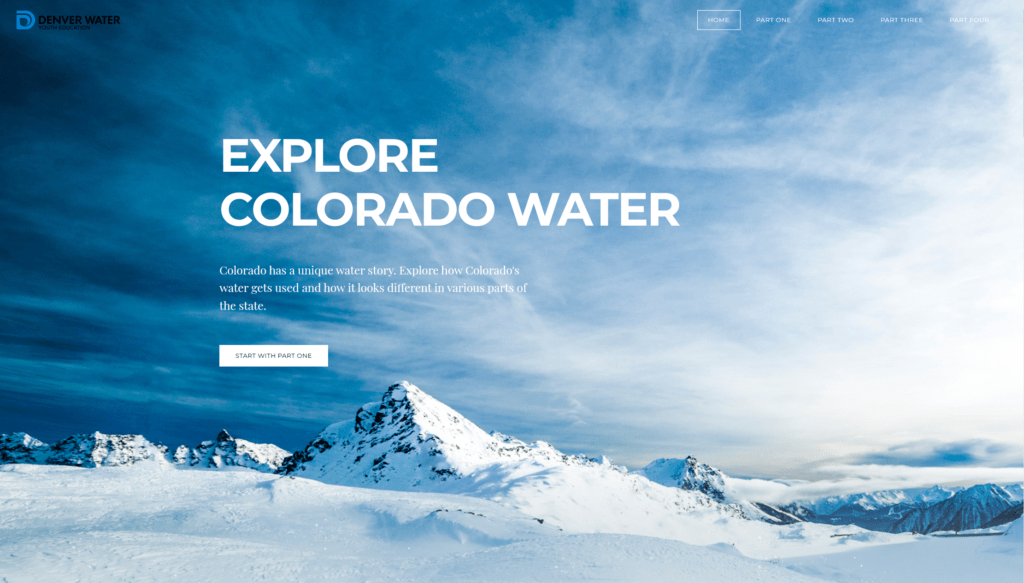Why and how companies are turning to brand journalism
As newsrooms shrink and media relations opportunities evaporate, more organizations are creating their own storytelling outlets. Here’s how to launch a robust news site of your own.
When Jay-Z launched Tidal, his streaming service, he compared music to water, claiming incorrectly that water is free.
“Music is $6 but no one wants to pay for music,” he said in a March 2015 interview with The New York Times. “You should drink free water from the tap—it’s a beautiful thing.”
The Times did not fact-check Jay-Z.
Tapped out
TAP, the digital publication produced by a team at Denver Water, did.
“I get what you are saying,” wrote Steve Snyder, the public utility’s head of communications, in an open letter to Jay-Z. “Artists should be paid for the music they create. But to say that ‘water is free while music is $6’ isn’t exactly true.”

Snyder, a former journalist, went on to explain that Denver customers paid $3 per 1,000 gallons of water; that some people can’t afford their water bills; and that water scarcity is a problem related to drought and climate change.
Snyder’s letter on TAP and the national publicity that followed are the product of Denver Water’s investment in brand journalism. It differs from content marketing and a traditional corporate blog in several ways.
“Brand journalism is very different from content marketing, because it’s not marketing. It’s journalism,” says Santa Fe-based strategic communications consultant Sally Covington, who launched TAP when she was heading up public relations and public affairs for Denver Water.
“Your strategy is to reach certain markets, like a marketing campaign, but it’s a journalistic way of doing it. It’s the nexus of marketing, journalism and social media.”
Covington secured support from Denver Water CEO/Manager Jim Lochhead and the executive team, emphasizing the goal of becoming a “trusted source” on water issues.
“You have to buy it anyway,” she says. “We wanted to change people’s values, attitudes, and understanding of water. We can do it through advertising, but I didn’t think it was appropriate. We wanted to do this through thought leadership with the business community, the chamber [of commerce], and nationally, as a forward leader in thinking about water in the West.”
The story(telling) behind brand journalism
Several factors are driving an increasing number of organizations to follow Denver Water’s example.
Firstly, organizations are complex. If your business is doing something right, then you have intelligent employees with informed viewpoints. You also have a community of customers and partners whose voices your company wants to magnify.
At the same time, local newspapers are financially struggling, laying off reporters, or closing entirely. As such, publicists have fewer journalists to contact. As those editorial doors close, similar roles at non-media companies are opening up, with Axios declaring “editor in chief” the job of the future.
“With brand journalism, the intention is to build reputation and promote expertise, not leads for somebody to sell something,” says Jim Ylisela, a former Chicago investigative journalist, author, and co-founder of Ragan Consulting Group, which helps companies and nonprofits set up journalistic-style newsrooms. (Denver Water is a former client.)
“[Some] audiences have grown weary and see through PR and marketing,” he says. “If you can cut through the clutter by telling a good story that has people in it, then [your audiences] will pay attention to you.”
News is the new PR
Ylisela and Mark Ragan, founder of Chicago-based Ragan Communications, started to teach the concept of brand journalism in 2012.
“People were already talking about and doing content marketing, but our approach was more journalism-based,” says Ylisela, a former professor at Northwestern University’s Medill School of Journalism.
Since then, Ragan Consulting Group has helped hundreds of organizations create newsrooms. The full engagement can last up to three years, with services including identifying the publication’s mission, audiences, and name; website layout and build; training corporate communicators how to think and write like reporters; and identifying ways to measure success.
Indeed, the intended outcome is a major difference between brand journalism and content marketing. As a public utility, Denver Water did not need more customers.
“They wanted to be a leading voice on water—water shortage, climate change, and drought,” Ylisela says. “They wanted to showcase their expertise, but to what end? Their reply was: ‘We’re going to have some very difficult conversations in the years ahead with our community because water shortages are going to continue, water is going to be more expensive and people are going to be mad about.’”
Sky writing
Another Ragan Consulting client is Pittsburgh International Airport. Former Pittsburgh Tribune reporter Bob Kerlik runs media relations and serves as executive editor of Blue Sky News.
Blue Sky News would not exist were it not for Christina Cassotis, who became airport CEO in January 2015. Having admired TAP, she hired Covington and Ragan to develop an editorial strategy specific to the airport.
Given the high editorial standards at both Tap and Blue Sky News, it’s clear that CEO buy-in is critical to the success of a brand journalism venture. Likewise, organizations that invest in so-called “brandjo” are innovating in other areas of their business to serve a larger ecosystem. For its part, Pittsburgh International Airport is recognized as a major contributor to the city’s high-tech renaissance.
Fast Company named the airport one of 2020’s most innovative companies in the world, a feat Kerlik covered as a regular news story, not a flashy press release with accolades.

From robotic scrubbers using UV light to the new Presley’s Place—a waiting room for people with sensory disorders such as autism—Blue Sky News is supporting the airport’s two business goals: attracting and retaining airlines, such as British Airways, and ensuring excellence in public safety, security and public health. As such, the editorial mission is to become the primary source of aviation news.
“We want it to look like a news site; we don’t want it to look like content marketing,” Kerlik says. “We have Blue Sky News to have journalistic-style stories because that’s what people want to read.”
That’s especially true given the COVID-19 pandemic, which has hit the airline industry particularly hard.
Up in the air
Kerlik and his team have been writing news and feature stories to educate myriad audiences: the local citizenry, the traveling public, and employees of the airport and the airlines with hubs there.
For example, Blue Sky News reported on a cargo company with a Federal Emergency Management Association (FEMA) contract to deliver essential supplies. “At the time [in May], masks were hugely important to the country, and we wanted to get the word out that masks were coming in from Seoul, Korea, through Pittsburgh,” Kerlik says.
Likewise, the economy was stalling. People weren’t traveling. When you’re running a news site for an airport, you need to arm the community with facts. This is especially true when local media outlets don’t have the resources to cover your steady stream of business news.
“At one point we had nearly 100 American Airlines planes parked on our center runway,” Kerlik recalls. “We did a video of our CEO standing in front of the planes. It was thought leadership of course, but we also wanted to let people know that we are part of the national critical infrastructure. We got picked up by a ton of national press—and brand journalism is a part of that.”
Brand journalism in the age of COVID
Another Ragan client, Blue Cross Blue Shield of Massachusetts, is likewise reporting on the pandemic, but from a healthcare perspective.
Jennifer Miller, former managing editor of the Boston Herald, has the same role at Coverage, the insurance provider’s news service. Coverage received a 2020 Gold Stevie international business award for its website. It also received a Silver award in the Covid-19 communications campaign category.
“Our site complements our corporate mission of providing access to quality, affordable health care for all,” Miller says. “We know health care is complex. Our mission as a brand journalism site is to help clarify those issues, with the ultimate goal of helping our readers attain better health along with improved understanding.”
Like Kerlik, Miller says it’s important to have a clear editorial mission and get out into the community to cover real people and issues. “Or else your site will just read like a bunch of press releases,” she says.
Just the facts
Morphing from a newspaper editor to brand journalism has been a relatively seamless experience, she says.
“It’s storytelling. It’s fact-based. It’s timely,” she says. “The idea is to get important health news out to the public. When I was at the Herald, my job was leading a team to report the most important local news of the day—with the best interviews, the best writing, the best videos—with real clarity and empathy.”
Now that she’s at Coverage, she adheres to those tenets while focusing on BCBS’s internal and external communities. Her team of writers and visual storytellers have been reporting on hot-button issues, producing well-reported stories and physician columns with blunt headlines.
When Racism Is the Medical Emergency (part of a series featuring Black physicians), A Child’s Right to Breathe, and How Am I Going to Take Care of My Mother? are three of the most-read stories on the site. Miller notes that all content is available for republication under a Creative Commons license.
Making an editorial statement
Back out West, two Denver communications professionals are experiencing a creative renaissance fueled by their tenacity and passion for brand journalism.
Sue Hermann and Megan Ryan are planning to launch The Statement, the new digital publication from Tulsa-based BOK Financial. The financial services company has operations in eight states, including Bank of Oklahoma and Bank of Texas.
Two years ago, Hermann and Ryan were running PR for CoBiz Financial, which BOK acquired.
“I went to a PRSA (Public Relations Society of America) lunch where Ragan spoke about brand journalism,” Hermann says. “I remember being so excited about the presentation. That’s how storytelling should go. I felt deflated because I wasn’t going to have a place to tell those stories. I was going to be out of a job.”
Hermann made a successful transition to BOK, where she is now director of communications; Ryan is her deputy. For the last year-and-a-half, they’ve been promoting the idea of brand journalism.
“We are fact-based and news-focused. This isn’t content marketing,” Hermann says. “It’s selling our expertise. It’s not selling our products and services.”
Expert opinion
As the digital design team prepares for The Statement’s end-of-year launch, Hermann and Ryan have been producing journalism-style articles that they’ve published elsewhere on BOK’s site. With Covid, they couldn’t wait.
“There was a need for turning around that info quickly,” Ryan says, referring to stories on stimulus checks and the government’s Personal Paycheck Protection Program. “These topics are really complicated. Our small but mighty team really stepped up to make this happen.”
Following Ylisela’s advice, the two women have learned to say no to certain requests to ensure editorial integrity.
Ten days ago, a member of BOK’s editorial team wrote a story entitled 5 Considerations for Bringing Employees Back to Your Workplace. One of the outside experts was a labor attorney, whose thoughts featured prominently in the article.
“The head of a line of business wanted his employee to be higher up in the story,” Ryan says. “But we kept [the quote] where it was. Our people were woven into the story; they were not the lead of the story.”
Adds Hermann: “It’s very easy to do this wrong. It’s much more a challenge to do it right. When you get it right, it’s pretty amazing.”
5 tips for a successful “brandjo” venture
1. Name it. Blue Cross Blue Shield’s Coverage is a play on words, referring to both editorial and healthcare coverage. The one-word title supports a clean, no-fuss design, Managing Editor Jennifer Miller says. BOK Financial’s The Statement recalls the mother of all documents—the bank statement—while also conveying a sense of finality and confidence, says BOK Financial’s Sue Hermann.
2. Keep it simple. Avoid marketing-speak and “fluffery.” It’s not an effective storytelling tool, Hermann says.
3. Learn to think and write like a journalist. This means learning the core tenets of storytelling: who, what, where, when, why, and how. Yes, you can interview your CEO but remember to also interview employees, customers, partners, and concerned citizens about the issues they care about.
4. Have a weekly “budget” meeting and daily check-ins with your team. Attend other departmental meetings to research story ideas.
5. Share stories in your organization’s email newsletter and on social channels. Pittsburgh International Airport’s email open and click-through rates are higher than the industry average, thanks to the high quality of Blue Sky News content, says Executive Editor Bob Kerlik.
Sally-Ann O’Dowd is a Fort Lauderdale, Fla.-based freelance journalist and communications executive. Read more of her work on Velocitize.






